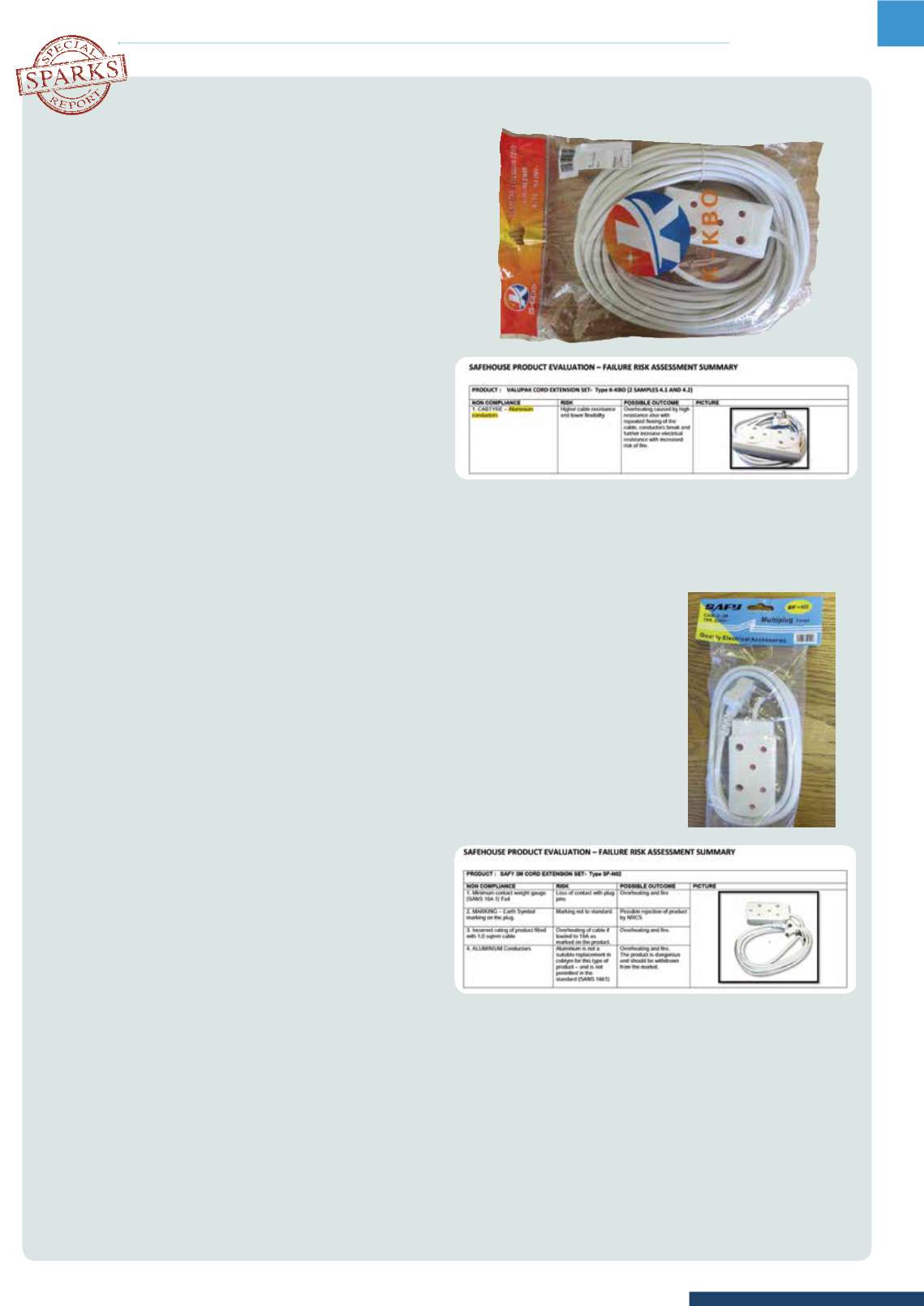

sparks
ELECTRICAL NEWS
june 2015
contractors’ corner
9
UNSAFE electrical products are potentially
lethal – whether it’s a dodgy extension cord or
a counterfeit earth leakage device. The good
news is that electrical contractors can now put
their combined force behind the SAFEhouse
Association to help rid this country of these
dangerous products.
Sparks
talks to Pierre Nothard, chairman of
the SAFEhouse Association, about its objectives
and achievements over the past two-and-a-
half years and, importantly, what the readers
of
Sparks Electrical News
can do to make South
Africa a safer place, electrically speaking…
Sparks: What is SAFEhouse?
PN:
SAFEhouse is a non-profit industry associa-
tion established to address the prevalence of
sub-standard electrical products and services in
South Africa.
Sparks: What are the objectives of
SAFEhouse?
PN:
The key objectives of SAFEhouse are to
inform the market, in its broadest possible
definition, of the prevalence of sub-standard
products and services; to alert users to the risks
associated with such products and services; and
to persuade the distribution channels not to
deal in such products and services.
Recently, SAFEhouse has also been tasked by
its members to engage with the NRCS (National
Regulator for Compulsory Specifications) with
a view to initiating co-operative action to deal
with this issue and with some other aspects re-
lated to the implementation of the regulations.
Sparks: To what extent have you achieved
your objectives?
PN:
Our market communications have been
consistent and, we think, informative. We do not
yet have the financial capability for widespread
consumer-type communications, but we have
been able to create increasing awareness in the
industry amongst those who distribute and
install electrical products.
Financial resources are, of course, necessary
for whatever we take on and, in this regard, we
have been pleased with the growth of member-
ship as this places us in a position to concentrate
more on dealing with specific issues of non-
compliance. This intensified concentration has
come about this year and has produced some
good results in alerting resellers to risky products
and getting sub-standard products returned
to suppliers. We have also just commenced a
process of engagement with the NRCS and there
are promising developments in this regard.
To summarise: SAFEhouse has made good
progress so far but there is still much work to
be done.
Sparks: What resources are available to
SAFEhouse to address the primary issues?
PN:
Philosphically, our major strength is our de-
termination to uncover the truth and courage
to advertise it. Physically, some would say we
are under-resourced relative to the enormous
size of the task, but we are very conscious of
the fruitless existence of industry associations
for their own sake and wish to avoid being a
bureaucratic cost-centre and little else.
We have, therefore, deliberately been careful
about a premature commitment to resources.
We make extensive use of members’consid-
erable skills, knowledge, facilities and other
resources to keep costs down and we have
employed experts as needed case-by-case
Sparks: What about membership?
PN:
So far we have focused a lot on growing the
membership base so as to acquire the financial
capability to do the job. With 34 members we
are now in a position to concentrate more on
identifying and dealing with specific instances
of non-compliance. Step-by-step, we will acquire
what is needed to continue progressing towards
a comprehensive andmore powerful capability.
Sparks: Can you clarify the involvement
of the NRCS and initiatives with any other
authorities?
PN:
From the beginning, we made our presence
Let's all be safe – take a stand against unsafe products
and our strategy known to the NRCS, the South
African Bureau of Standards (SABS) and the
Department of Trade and Industry (dti) and we
have, as a matter of course, submitted formal
reports about the cases we have investigated
to the NRCS. This did not lead to anything in
the way of co-operative activities but we have
recently taken the initiative to develop such
co-operation.
Sparks: What are the major challenges
SAFEhouse faces?
PN:
There are three major challenges: First,
the apathy of our industry. We are good at
complaining, but not so good at imagining
what can be done and worse at committing to
action.
For example: The lighting sector is riddled
with sub-standard products but we have few
specialist members from that sector and we get
very few lighting cases reported to us.
Secondly, many of the cases reported to us
do not have enough information to enable us
to act on them. SAFEhouse is increasingly tak-
ing the initiative to itself patrol for sub-standard
products and services.
Thirdly, sufficient funding is always an issue;
as we all know, there is never enough money.
SAFEhouse is funded by its members and
getting entities to participate in the current
economic environment is not easy. The drive for
membership remains a priority.
Sparks: Discuss the successes and failures, if
any, of SAFEhouse.
PN:
My biggest disappointment is our failure to
attract more of the retail sector to support the
SAFEhouse initiative. That channel clearly has
a huge influence on which products are avail-
able to the residential market in particular. It is
regrettable, perhaps telling, that the attitude is
often:“What’s in it for us?”
Successes? The growth in membership has
been pleasing. During the past fewmonths, we
have had three cases of non-compliant prod-
ucts being voluntarily removed from shelves
by retailers after we had alerted them. We also
sense an increasing awareness of the SAFE-
house initiative and, more importantly, of the
issues we deal with. It is now becoming easier
to get the attention of senior people who are
able to take quick, decisive actions about the
products contained within their offerings.
Sparks: Does SAFEhouse have any current
cases pending, howmany and what is the
nature of these cases?
PN:
We currently have nine cases on the go.
The issues are typically around the use of sub-
standard components, for instance cable that
uses sub-standard conductor-material, and also
dimensional and other such aspects that under-
mine safe electrical connection in products.
Sparks: It is said that some of your members
themselves deal in sub-standard products …
PN:
It is significant that four of the current cases
involve members lodging complaints about
another member’s products. We encourage this
and deal with every case as we would if it were
otherwise. Of course SAFEhouse members,
having committed to the code of conduct, are
immediately receptive and co-operative.
Sparks: What are the future plans and focus
areas of the association?
PN:
SAFEhouse will continue the drive for
membership; we will concentrate more on pur-
suing and exposing cases of non-compliance;
and we will develop and implement co-opera-
tive actions with the NRCS.
Sparks: How can electrical contractors assist
SAFEhouse?
PN:
The readers of
Sparks Electrical News
can
help themselves and, in the process, SAFE-
house, in a number of ways:
First, they should be aware of – and opposed
to – the prevalence of sub-standard products
and installations; actively be on the look-out for
these and report them to SAFEhouse with the
following information:
In the case of sub-standard products:
• The reason for suspecting sub-standard sta-
tus (not just ‘a shot in the dark’).
• Product identification (a photograph is ideal).
• The identity of the seller and/or installer.
• The location of the seller/installer – an
address is certainly helpful.
• Their own contact details – at least a
telephone number or an email address.
In the case of a sub-standard installation, we
need the following information:
• The reasons for suspecting the sub-standard
status.
• The address of the installation.
• A photo of the problem area if possible.
SAFEhouse can send a photographer if the
installation is accessible and sufficiently illus-
trative.
• The identity of the installer, if possible – or at
least a ‘lead’.
• The contact details of the end-user (at least a
telephone number or email address).
• Their own contact details
I should emphasise that we do not reveal the
identity of the complainant. The issue is not
about who complains – it is about validating
can contact us with information and we will
investigate and expose installations that are
significantly sub-standard and which present
a safety risk to users. Of course non-ECA(SA)
members can also contact us. We cannot react
to relatively minor instances. It depends on the
size and consequence of the matter to the user
and exposing the issue, whether product or
service.
Sparks: What should contractors look out for
when selecting products?
PN:
Contractors should be suspicious when
they come across prices that are substantially
below the going rate for a product. Avoid un-
branded products. Check for proper markings
on the products – if the contractor is not sure
what to look for, they are welcome to contact
Safehouse for further information. Buy reputa-
ble brands and deal with reputable wholesal-
ers. If in doubt, check with SAFEhouse for any
information they may have about a particular
product.
Sparks: How can SAFEhouse be of benefit to
electrical contractors?
PN:
The Electrical Contractors’Association of
SA is a member of SAFEhouse so members
as to whether we can take it on or not. With
good information, we are able to warn potential
customers if they are contemplating dealing
with a contractor who may be ‘suspect’. We can
also provide contractors with information about
products and contractors that we have investi-
gated and possibly about others.
Sparks: How can companies join SAFEhouse?
PN:
Anyone wanting to join SAFEhouse or who
wants to knowmore about the association can
call me. To join SAFEhouse, companies must be
signatory to the SAFEhouse constitution and
code of conduct and commit to the member-
ship contribution.
Enquiries: 083 414 4980
For more information
email Pierre Nothard at
pierren@safehousesa.co.za
















